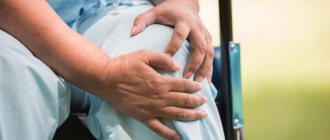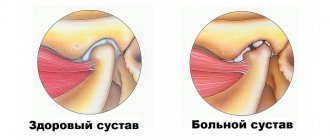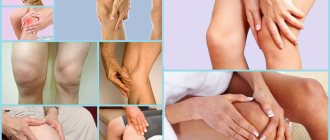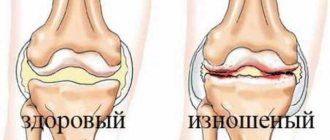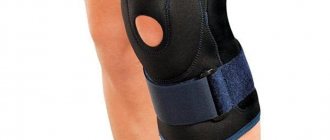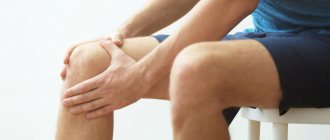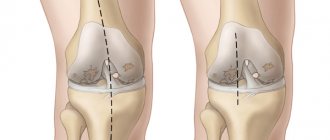Definition and functions of the meniscus Classification of injuries Possible causes of pathology Symptoms of a meniscus tear Degrees of severity of a meniscus tear Diagnosis of a meniscal tear Treatment of a meniscal tear of the knee joint Prevention of a meniscal tear of the knee joint
The knee joint is the most vulnerable part of the human body
, which is exposed to constant trauma and damage in everyday life. One such injury is a torn meniscus of the knee joint.
This closed injury is rarely accompanied by persistent pain.
, and therefore can remain unnoticed for a long time not only by the patient himself, but also by doctors. There are often cases when the victim is simply sent on sick leave with a recommendation not to put any weight on the sore leg.
But a meniscus tear is an insidious disease
, which leads to the development of intra-articular pathologies. It often provokes the appearance of erosions of the joint capsule, arthrosis and other degenerative and inflammatory diseases associated with deterioration of depreciation in the joint.
Young, physically active people between 20 and 40 years old are most susceptible to meniscus injuries, but a tear can occur at any age
. Elderly patients with problem joints are also susceptible to it. Let's figure out how to treat a meniscus tear in young and old people and what complications this condition is fraught with.
A torn meniscus is a common knee injury.
Definition and functions of the meniscus
The meniscus is a cartilage pad measuring about 6 cm and about 3-4 mm thick that is present in the knee, shoulder, ankle and some other joints.
This spacer is located inside the joint (between the articular surfaces) and has a C-shape. Each knee has 2 menisci - one on the inside (medial menisci, firmly secured by ligaments) and on the outside (lateral menisci, more mobile). They perform the following functions:
- depreciation
- absorbing shock loads on the joint when running, walking, jumping; - protection of subchondral bones
- the meniscus protects the bones that form the knee joint from the loads associated with upright posture (distributes them evenly over the entire surface of the joint, preventing rapid wear of the protruding parts); - ensuring congruence (coincidence and optimal interaction) of the articular surfaces
- plays the role of a seal in the joint.
Manifestations
Possible changes in the lateral cartilage that occurred as a result of an injury in the recent past are indicated by fairly pronounced symptoms:
- The pain, which is predominantly localized along the outer edge of the knee, is of significant intensity and intensifies with the slightest attempts to perform movements.
- Decreased range of motion, which is accompanied by increased sensations of discomfort. When a part of the cartilage is completely torn off, displaced and wedged, a block of movements occurs.
- Inflammatory signs - any damage is accompanied by the development of an inflammatory reaction, which is characterized by hyperemia (redness), swelling with an increase in the knee in volume, as well as a local increase in temperature (tissues become hot to the touch).
Changes that develop as a result of pathological processes are accompanied by a long and gradual development of clinical signs. The pain becomes more intense after exercise on the leg and usually intensifies in the evening. The movements are accompanied by a characteristic noise in the form of clicks or crunches.
Damage classification
Damage due to a rupture of the meniscus of the knee joint can have different etiologies. So, they can arise due to:
- injuries due to external force or incorrectly redistributed load;
- degenerative changes in the joint (age-related or associated with wear of the meniscus).
As a rule, in both cases, damage also affects other components of the musculoskeletal system - ligaments, tendons, muscles, synovial cartilage.
A meniscus tear can be:
- complete
- in this case, the knee is sharply immobilized due to a sharp narrowing of the gap between the tendons and the joint capsule, any attempt to move causes damage to the tendons and pain; - partial
- can be practically asymptomatic or accompanied by pain, swelling, and stiffness.
There are other bases for classifying meniscal injuries:
- which meniscus is affected: lateral or medial;
- localization of damage: body of the meniscus, anterior or posterior horn, complex;
- according to biomechanical disorders: stable, unstable;
- ability to recover: complete, with the help of surgery, unrecoverable;
- according to the shape of the gap: patchwork, “watering can handle”, “parrot’s beak”.
Etiology
Damage to cartilage in the form of a rupture of varying severity occurs due to the influence of various etiological (causal) factors, the most common of which are:
- Previous or acute knee injury that results from excessive flexion of the joint, a blow or fall on the joint, or twisting of the leg (rotation of the hip while the shin is locked). Traumatic changes predominantly occur in young people who lead an active lifestyle or engage in outdoor sports.
- Degenerative-dystrophic changes in cartilage tissue, developing against the background of age-related changes, nutritional disorders (trophism) and leading to a decrease in its strength. This reason often occurs in older people, which is associated with general age-related changes (involution processes).
- Congenital weakening of cartilage structures, caused by changes at the genetic level (the functional activity of genes responsible for the synthesis of the intercellular substance of cartilage tissue changes). Damage to the meniscus in this case develops against the background of normal stress in children or young people.
- Long-term inflammation of the structures of large joints, leading to disruption of their functional state. This etiological factor occurs during the development of an autoimmune pathological process (rheumatoid arthritis, rheumatism), characterized by the formation of autoantibodies by immunocompetent cells that affect their own tissues, mainly the structures of the musculoskeletal system.
Knowledge of the factors that became the main cause of meniscus damage allows a medical specialist to select the optimal rehabilitation, as well as make recommendations regarding the prevention of its development.
Possible causes of pathology
The cause of a meniscus tear can be careless movement, prolonged stay in an uncomfortable position, or other high load on the cartilage pad.
At a young age, a meniscus tear is usually provoked by professional and amateur sports - team sports (volleyball, basketball), badminton, running, gymnastics, wrestling - because the cartilage plate of the knee is not designed for such loads. Professional athletes can withstand them only by strengthening the muscular-ligamentous apparatus. But when the load is decompensated (for example, an unsuccessful eversion), it injures the meniscus of both a trained and an ordinary person with equal effect.
The following factors contribute to a tear of the knee meniscus:
- chronic or repeated traumatization of the meniscus or other parts of the joint architecture - for example, when performing heavy household and professional duties (loaders, masons, dancers, farmers);
- sports and sports injuries;
- habit of squatting for a long time;
- age-related changes in joints;
- chronic diseases - systemic and joints (rheumatism, arthritis, gout, intoxication of the body, autoimmune diseases);
- excess weight.
Traumatic meniscus tears usually occur during so-called “twist” movements—rotational movements of the legs with a load on the knee. It can be caused by a sharp movement of the knee inward or outward (twisting the leg), a deep squat (especially with a barbell or other load), a blow to the knee, or displacement when lifting weights. In old age, it is enough to just get up from a chair or squat and rotate your leg in the joint.
The victim of such unfortunate accidents is usually the medial (inner) meniscus of the joint.
Among the traumatic causes of meniscal tears, the leading ones are:
- jumping from heights;
- an unsuccessful fall to your knees;
- spinning on one leg;
- joint hypermobility;
- failure to comply with safety precautions when exercising in the gym or performing eversion exercises;
- running on rough terrain (or on a path with natural uneven ground);
- dislocations and subluxations of the knee joint.
Sports injuries are the most common cause of knee meniscus tears.
knee bandage
knee bandage
- Providing rest for the lower limb, which is achieved by tightly bandaging with an elastic bandage or applying a splint using plaster.
- Periodic treatment (usually 1 or 2 times a day) of sutures with antiseptics to prevent infection.
- Drug prevention of complications, in particular bleeding with the help of hemostatic agents, as well as bacterial infection by prescribing antibiotics.
Typically, the postoperative period lasts from 3 to 10 days and ends with the removal of sutures after tissue regeneration. After arthroscopic surgery, this period is shorter – no more than 5 days.
Symptoms of a meniscus tear
Immediately after injury, victims experience acute symptoms of a meniscus tear, which, however, can be masked by concomitant injuries - bruises, sprains, dislocations, and ligament tears. Therefore, the patient can learn about a rupture of the meniscus of the knee joint only 3-4 weeks after the incident, after the remaining causes of inflammation and pain have subsided.
Characteristic symptoms of a meniscus tear
and traumatic pathological process are:
- acute pain in the knee joint;
- blocking movement in the joint (due to pain or swelling - may be complete or incomplete);
- stiffness, stiffness of the joint;
- extensive swelling that occurs due to inflammation or hemorrhage in the joint capsule.
In people over 40 years of age, symptoms of a meniscal tear not related to injury may be virtually absent. In their case, the damage appears as a result of a chronic degenerative process. The pain is usually long-lasting (the patient “gets used” to it) and slowly progresses.
Regardless of the cause of the tear, patients may experience a feeling of uncertainty in the joint when stepping on the affected leg. This symptom of a meniscus tear becomes especially noticeable when going down the stairs, which is harder for most patients than going up. They feel like the joint is “wobbly”, as if something is missing. Over time, the discomfort increases.
What treatment methods are used at the Quality of Life clinic?
A properly designed rehabilitation treatment program will shorten the recovery period, reduce the risks of serious complications (including post-operative ones), and allow professional athletes to return to their normal rhythm of life and return to training. We have established methods and experience in treating representatives of all sports after injuries: skiers, basketball players, athletes, gymnasts.
The key to effective recovery after injuries to the knee joint is an integrated approach. If a meniscus injury occurs, the patient is treated by a well-coordinated team of specialists - an osteopath, a psychologist, a neurologist, and a rehabilitation specialist. We have the necessary experience and equipment to deliver treatment safely and effectively. Gradually, step by step, we will help restore motor activity after damage to the meniscus of the knee joint and restore lost joint functions.
Osteopathic correction
Osteopathic treatment methods allow in some cases to avoid surgery on the menisci and restore their function naturally. In addition, osteopathic correction allows you to reduce the dosage of potentially unsafe medications, and sometimes completely stop taking them.
Soft manual techniques: • reduce pain in the menisci; • increase mobility in the joint; • eliminate swelling and inflammation.
If permanent injury to the menisci of the knee joint is associated with scoliosis, pelvic or sacral misalignment, planovalgus foot deformity and other skeletal deformities, osteopathic correction eliminates these causes.
In addition, osteopathic treatment methods remove obstacles - congestion in blood vessels, ligaments of the knee joint, muscles surrounding the meniscus, as well as in nervous tissue that is not present in the meniscus.
Possibilities of physical therapy exercises
Osteopathic correction at the Quality of Life Clinic is complemented by physical therapy. Performing general developmental exercises can improve blood circulation in the injured leg and strengthen muscles and ligaments. In the first days after removing the splint, exercises are performed in a gentle manner.
For the rehabilitation of patients, exercises are also prescribed in the Neurac kinesiotherapy unit. Gravity loads in a rehabilitation simulator train stabilizer muscles, improve coordination and restore anatomically correct biomechanics of movements.
Severity of meniscus tear
When a meniscus is damaged, there are 3 degrees of severity, which are determined using MRI:
- The 1st degree is characterized by a small point disturbance in the structure of the cartilaginous lining (in its inner part);
- In grade 2, a crack is diagnosed that does not touch the edge of the meniscus. There is no fragmentation of the meniscus.
- A grade 3 meniscal tear is characterized by complete separation of the cartilage, with a linear lesion extending to the edge of the meniscus.
Symptoms of a torn meniscus also vary depending on the severity:
1st degree
— there are no pronounced pain sensations, as well as limitation of mobility in the joint. There may be a crunching sound when bending the joint, discomfort or mild pain during certain specific loads (squats, turns, long walks, climbing stairs). A small amount of fluid may accumulate under the knee - swelling is usually only visible when comparing two knees side by side.
2nd degree
- Patients feel severe pain. There is usually a noticeable limp during gait, caused by spontaneous or permanent blocking of movement in the joint. With a moderate meniscus tear, patients cannot fully straighten their leg even with outside help. Swelling in the knee area is very pronounced; bluishness of the skin is possible due to impaired tissue trophism.
3rd degree
Meniscus tear - the pain is sharp and excruciating; any movement of the leg causes pain in the patient. The limb is constantly in a half-bent state without the ability to straighten it. The skin in the area of edema with a 3rd degree meniscus tear has the appearance of a blurred hematoma and acquires a purple tint.
How to prepare for the procedure
Special preparation is not required before MRI with further classification of the condition of the Stoller meniscus. The study is subject to the same contraindications as MRI, and primarily the presence in the body of metal elements and various electrical stimulators and insulin pumps, the operation of which can be affected by the magnetic field of the device.
There will be no pain or discomfort during the examination. The only thing that the patient needs to take into account is that the procedure is lengthy. If the patient is very nervous before the examination, it is recommended that he take valerian or another herbal sedative.
Diagnosis of meniscus tear
As mentioned above, diagnosing meniscus injuries is complicated by injuries to nearby soft tissues. Therefore, even contacting a traumatologist does not guarantee an accurate diagnosis.
without additional hardware research. Palpation and motor tests can be made more difficult by swelling or pain in the knee or long-term use of painkillers.
Functional tests for diagnosing a meniscus tear include: Chaklin's test, Shteiman's symptom, Baikov's method, Polyakov's symptom, Landau's test, McMurray's method, Perelman's symptom.
The most common diagnostic methods include:
- computed tomography or magnetic resonance imaging (also helps to determine the condition of ligaments, tendons, cartilage, muscles, and to determine the presence of microfractures that are invisible on an x-ray);
- arthroscopy.
These techniques are necessary to accurately determine the location of the rupture and the extent of damage. X-ray and ultrasonography are not informative methods of research, since they do not provide a complete picture and can give false results.
Diagnostic studies help determine the presence of microtrauma that is undetectable by simple examination. Although microtrauma to the meniscus is not a tear, it can have unpredictable consequences for the knee joint as a whole and therefore also requires treatment.
Treatment of a torn meniscus of the knee joint
First aid for a knee injury that is accompanied by severe pain is immobilization (using a splint or splint) and cooling (using an ice pack or sports cooler). Then the victim must be taken to a traumatologist as soon as possible to receive adequate treatment. This approach significantly reduces the risk of complications from a knee meniscus tear.
Meniscus tears are divided into:
- separation at the point of attachment to the joint (the damage can heal with bed rest and immobilization of the limb with a splint);
- rupture in the central part (requires surgical treatment);
- flap rupture (the most severe damage).
The choice of treatment strategy for a tear in the meniscus of the knee joint is also influenced by which meniscus is damaged. The medial (internal) meniscus is much less well supplied with blood vessels, so its rupture requires longer treatment and the use of auxiliary drugs (for example, intra-articular administration of glucocorticoids).
After an accurate diagnosis, the doctor chooses the direction of treatment - conservative or surgical
. The first is to fight inflammation, accelerate the regeneration of cartilage tissue, and relieve pain. The limb is immobilized or protected with a compression orthosis; if necessary, a puncture is performed (removal of fluid accumulated in the joint, be it blood or effusion), and ice compresses are applied (about 20 minutes a day).
Surgical treatment for a knee meniscus tear involves arthroscopy.
Immobilization of the knee - first aid for a torn meniscus
Physiotherapy for a torn meniscus
Physiotherapy is especially advisable during the rehabilitation period after a torn meniscus of the knee joint. It is designed to strengthen the muscles of the thigh and lower leg, naturally reducing the load on the knee joint, and also fully restore mobility in the joint. This is facilitated by:
- mechanotherapy;
- kinesiotherapy;
- ultra-high frequency therapy (UHF);
- electromyostimulation;
- massage;
- taping.
These types of physiotherapy are used to relieve spasm, restore atrophied muscles, and improve innervation.
When treating a knee meniscus tear, only anti-inflammatory techniques are usually used, for example:
- physiotherapy;
- medicinal electrophoresis;
- cryotherapy and thermotherapy;
- ultrasound.
They are also used to relieve swelling before meniscus surgery.
Drug treatment of a torn meniscus of the knee joint
In the conservative treatment of a rupture of the meniscus of the knee joint, as well as after surgery, patients are prescribed non-steroidal anti-inflammatory drugs to relieve swelling and pain, and improve soft tissue trophism. eliminating “inflammatory” enzymes that destroy articular cartilage.
If NSAIDs do not provide sufficient effect and do not reach the meniscus well, the doctor may decide on intra-articular injections of corticosteroid hormones and hyaluronates. This procedure allows you to relieve pain and inflammation within 15-20 minutes after administering the medicine.
In case of poor blood circulation and injuries of the medial meniscus, blood microcirculation correctors are additionally connected.
Chondroprotectors play almost the central role in the treatment of meniscal tears of the knee joint. These are preparations enriched with natural polymers - components of cartilage tissue and synovial fluid. Chondroprotectors
accelerate the regeneration of cartilage tissue, serve as a prevention of complications (from joints and ligaments), and ensure fusion of the meniscus with minimal scarring of the tear. They help relieve inflammation, improve nutrition of the joint and improve the shock-absorbing function of cartilage.
It is especially important to take chondroprotectors for degenerative meniscus tears - when the cartilage tissue is already severely worn out, has a low potential for recovery and needs to be recharged. In this case, chondroprotectors should be taken for life, in annual courses of 3-6 months.
One of the most effective chondroprotectors is the drug Artracam.
.
Surgery
Modern surgical treatment for knee meniscus tears is usually performed in the form of arthroscopy. Since arthroscopy is a diagnostic procedure, minimally invasive surgery during its process can be performed immediately after clarifying the location and extent of the meniscus tear. The surgery begins with the insertion of a microscopic camera into a tiny incision (1.5-3 cm) and takes only 30 minutes.
After the examination, the doctor makes a decision on stitching, resection or removal of the meniscus. Stitching the edges with bioabsorbable suture material is usually indicated for 1st and 2nd degree tears of the meniscus of the knee joint - after this operation, rest for the affected limb is required for 3-4 weeks. Stitching is especially effective for lateral tears of the meniscus of the knee joint, as well as for fresh injuries.
Resection involves partial removal of a fragment of the meniscus that blocks movement in the joint, or severely damaged tissue, followed by grinding of the edges. If most of the meniscus is preserved, the patient does not feel any discomfort or changes in sensations after surgery. After 3 weeks of rehabilitation, athletes can return to training.
Complete removal (meniscectomy) is performed in exceptional cases and only for grade 3 meniscal tears. Removal is recommended for old ruptures or complex injuries, when reconstruction is impossible, as well as for severe damage to the meniscus, excessive looseness of cartilage tissue (arthrosis and other chronic diseases). Rehabilitation after such an operation is more complex, and the shock-absorbing characteristics of the joint worsen (patients are recommended to take lifelong chondroprotectors and be monitored by a rheumatologist). However, with arthroscopic removal of the meniscus, the patient can step on the affected leg on the day of surgery - using a walking stick or crutch. If medical recommendations are followed, motor activity does not suffer after meniscectomy.
Recovery time
after arthroscopy of the meniscus of the knee joint are individual. Typically patients require:
- 3 days before discharge from hospital;
- 2-4 weeks for recovery at home.
In this case, disability (depending on the profession) lasts from 2 to 6 weeks. Driving is allowed 6 weeks after surgery.
Gymnastics and exercises for meniscus tears
Performing gymnastic exercises for a torn meniscus of the knee joint is allowed only during the recovery period
, after complete removal of inflammation and with the permission of the attending physician. The physical therapy instructor (PT) selects the following groups of exercises for the patient;
- training the muscular-ligamentous apparatus to strengthen the knees (sit down/stand up from a chair, shift your body weight first to one side, then to the other, step-up exercises);
- strength training (mainly for the thigh muscles) and flexibility training;
- training for coordination of movements and maintaining balance, which prevent re-injury of the knees and help to work the deep muscles;
- workouts to maintain general tone.
The exact list of exercises is selected by a specialist taking into account the general health, constitution, physical fitness, age of the patient and other factors. Rehabilitation after surgery involves a gradual increase in loads.
Conservative therapy
Conservative therapy
Once a medial meniscus tear has been diagnosed, treatment without surgery is prescribed only on the basis of certain criteria, which include the location, characteristics and severity of the damage. The medical specialist must take into account the cause of the pathological condition.
It is usually possible to prescribe conservative measures if small changes have been identified that do not extend beyond the surface of the cartilage. An incomplete meniscal tear can be treated without surgery using medications, physical therapy, and rehabilitation measures. During treatment, the knee is provided with functional rest, which is achieved by immobilization (immobilization) using tight bandages or a plaster splint.
Prevention of knee meniscus tear
To ensure you never wonder how to treat a knee meniscus tear, you should take the following precautions:
- Be sure to warm up before any physical activity.
- Avoid deep squats, sudden and twisting movements.
- Monitor your weight and consume a balanced menu high in vitamins and minerals.
- Do not neglect moderate sports loads to maintain the muscular-ligamentous apparatus and stabilize the knee joint.
- After 40 years, start taking prophylactic chondroprotectors, even if there are no symptoms of a meniscus tear.

